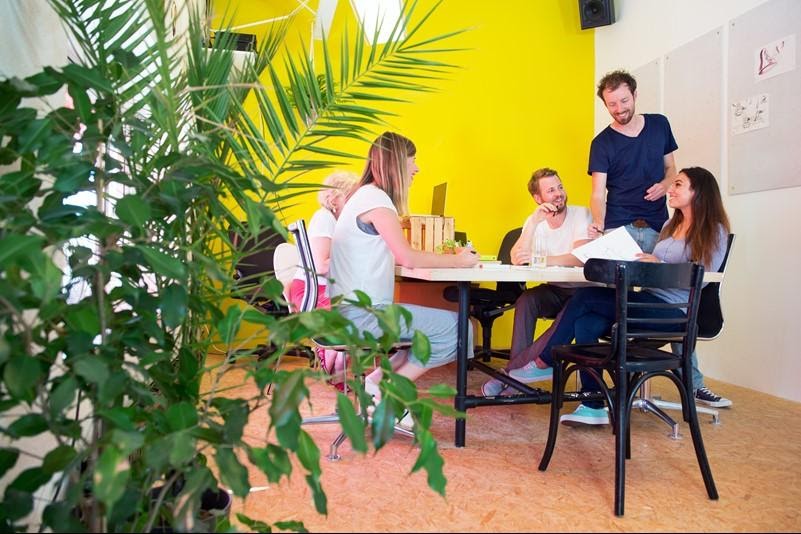
There’s a good reason why many companies are becoming more intentional about incorporating earth-friendly practices inside their business. A greener workplace can result in a smaller carbon footprint, a healthier and more productive workforce, and better news for your company’s bottom line.
Want to join in, but unsure how to start? Reducing your office’s ecological impact is simpler than you may think.
New technologies and an overall push towards conservation have made sustainability in the workplace a realistic goal. Whether you're a part of a large or small company, whether your office is green already or just getting started, there are a couple of simple changes that can lay the groundwork for a healthy, low-impact workplace.
The following tips will not only help the environment but provide benefits to both your business and employees:
Refine Your Commute

Since your workday begins with commuting, it might be time to rethink your transportation methods. The “greenest” way to work is telecommuting. While most companies require employees to work in the office, creating a flexible schedule – where employees can work remotely one or more days per week – holds tremendous benefits. Videoconferencing, phone calls, and online seminars have made working from a remote location reality.
However, if your office requires you to come in – and walking isn’t an option – consider carpooling or public transportation. Recent studies show that traditional bus and metro ridership has declined in the past five years, but car and bike-sharing apps have increased. With these new technologies, it's easier to partner up and find a commuter buddy.
Go Paperless

The “greenest” paper is no paper! One of the most effective ways your workplace can be more eco-friendly is reducing paper waste. Use electronic forms and contracts whenever possible, email letters and documents rather than printing, and limit your production of brochures and marketing materials. Encouraging team members to bring their tablets and laptops to meetings will limit handwritten notes and printed documents.
Additional benefits of a paperless office include: reduced clutter, reduced printing costs, faster communication, and more efficient data.
Switch the Lighting

There is a multitude of reasons why your workplace should switch from traditional incandescent and fluorescent bulbs to LED lights. Lighting uses an excessive amount of energy and comes from coal-burning plants that pollute the environment. Businesses will benefit from switching from traditional lighting to LEDs because they are energy efficient. They’re also proven to be more affordable and have a longer life span of up to eleven years, meaning the need to manufacture and produce more lights is reduced, which results in fewer emissions.
Additionally, the installation of motion-sensor light switches will reduce the use of electricity in less-commonly used areas such as conference rooms, phone booths, and private offices.
Make Devices More Efficient

Going paperless requires employees to maximize the use of their digital devices, so it’s important to make them as efficient as possible. According to the International Energy Agency (IEA), computers and consumer electronics are responsible for 15% of the world’s residential energy consumption – a huge amount!
Change your device’s settings by putting them on “standby” or “hibernation” mode when they haven’t been used for more than five minutes.
When employees are using their devices, encourage them to turn down the brightness level. If the brightness is turned down by half, it will reduce battery usage and energy being used.
Finally, skip the screensaver! Active, moving screensavers don’t save energy. Screensavers were originally created to stop images from “burning” into the monitor – but this type of monitor is rarely used today.
Bring in Green (Literally)!

Investing in real plants adds natural beauty to your surroundings while improving the quality of indoor air. This can be especially important if your workplace is in a newer building that is tightly sealed to conserve energy. Older buildings are known for containing harmful pollutants from fire-retardants, pressed-wood products, and plastic-coated wallpapers.
Indoor plants are a holistic way to defend against these contaminants while boosting employees’ mood and productivity. A win for both your employees and business!
Enjoy Your Meal Break

And after you do, get rid of your plastic utensils, paper plates, and foam cups. Invest in washable dishware and utensils to reduce waste. Encourage employees to bring lunch and snacks from home in reusable containers – or frequent restaurants that support sustainability and locally sourced foods.
If your team values a good cup of coffee, use fair-trade, shade-grown coffee in reusable coffee filters. Not only is organic coffee better for you, but the shade-grown beans help to protect the biodiversity in the ecosystems to which it’s grown. This is the perfect time to get coffee mugs with your company logo for visitors and employees to use!
Be Mindful Before Relocating

If you’re thinking about relocating to a new space, there are several “green” items to include on your checklist. Look for LEED-certified buildings. LEED certification is a globally recognized ranking system built on several categories, including sustainable sites, energy and atmosphere, and indoor environmental quality.
Keep an eye out for well-insulated spaces, so you won't be required to use excessive heating or air conditioning.
When you’re inside the new space, make sure to monitor the use of lighting and other electronics. Minimizing electricity consumption can help you make major strides towards becoming a more eco-friendly business.
While it is impossible to entirely remove your carbon footprint, every small change counts!
Need more tips for making your workplace green? Contact us for the newest eco-friendly products, tips, and expert advice to reach your workplace goals.
For more information, check out our articles on Employee Retention and Workplace Productivity.



